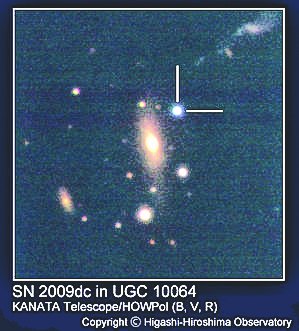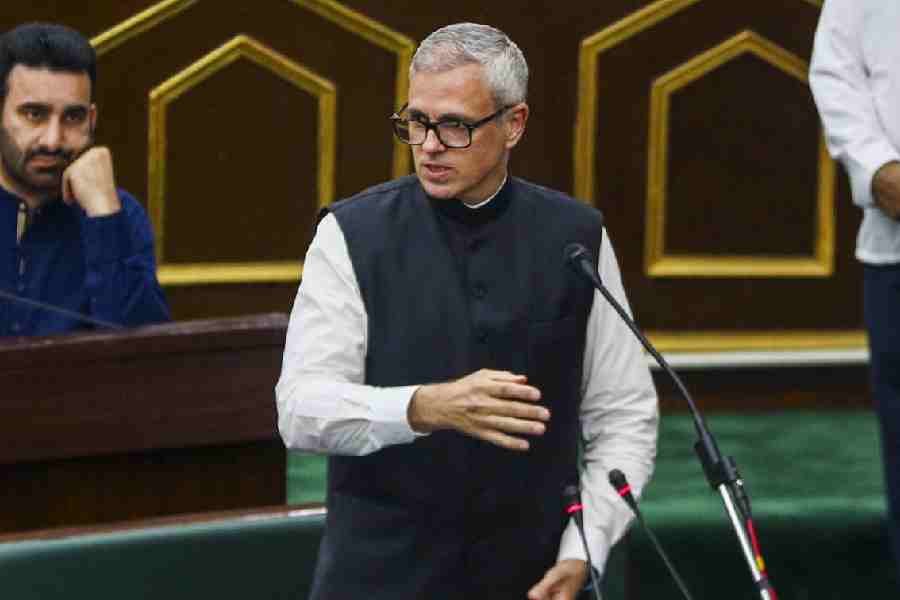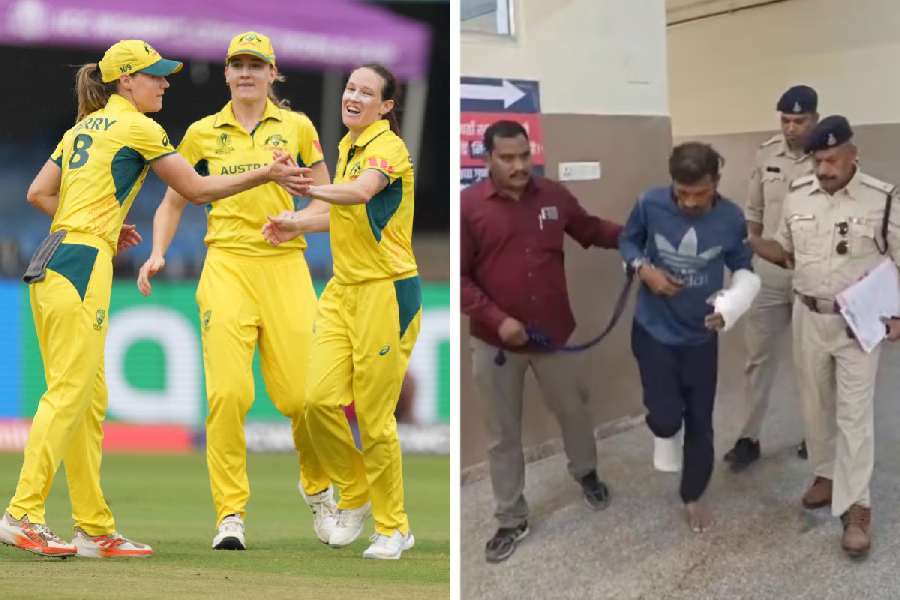
named SN2009dc (at the intersection
of the two white perpendicular lines)
located in a distant galaxy
New Delhi, April 16: Indian physicists have tweaked the ideas of Nobel laureates Albert Einstein and Subrahmanyan Chandrasekhar to propose a solution to a 25-year-old astronomical puzzle related to the luminosity of exploding stars called supernovae-1a.
The researchers at the Indian Institute of Science, Bangalore, have explained why a small number of supernovae-1a are defyingly brighter or bafflingly dimmer than expected, using a modified version of Einstein's theory of gravity and rewriting a rule formulated by Chandrasekhar during the 1930s.
Supernovae-1a are violent end-of-life explosions of a class of stars called white dwarfs that have been viewed as "standard candles" in astronomy because of their uniform luminosities. Several hundreds of these supernovae-1a have the same inherent brightness. But since the early 1990s, astronomers have been puzzled by observations of at least 12 supernovae that are brighter and at least 15 that appear dimmer than the standard candles.
"Changes to both Einstein's theory of gravity and Chandrasekhar's original formulation may be indispensable to explain over-luminous and under-luminous supernovae-1a," said Banibrata Mukhopadhyay, associate professor at the IISc who led the research.
During the 1930s, Chandrasekhar had predicted through calculations that white dwarf stars could have masses at most 1.44 times the mass of the Sun. Studies and observations since then have shown that white dwarf stars that explode as supernovae-1a have near-uniform luminosity, linked to the internal chemistry of the stars.
Mukhopadhyay and a team of research scholars and students at the IISc, looking for explanations for the puzzling over-luminous and under-luminous supernovae-1a, borrowed a version of the theory of gravity proposed by Einstein in 1915, but modified by a Russian cosmologist Aleksei Starobinsky in 1980.
In an earlier study, the IISc scientists had shown that some white dwarf stars may acquire masses up to 2.5 times the Sun's mass before they obliterate themselves as supernovae, challenging the 1.44 mass limit imposed by Chandrasekhar and viewed as a sacrosanct number for decades.
The scientists have now applied the modified Einstein's theory of gravity on white dwarf stars and found that the Chandrasekhar mass limit is not a unique number, but can take a range of values - any number between 0.5 to 2.8, depending on the density of matter packed in the stars and on the modification to the theory of gravity itself.
"The higher-mass stars are progenitors of over-luminous supernovae-1a and the lower-mass stars are progenitors of the under-luminous supernovae-1a," Mukhopadhyay said. The results of the new study have been accepted for publication by the Journal of Cosmology and Astroparticle Physics.
While Einstein's theory of gravity -- more commonly called the general theory of relativity -- has passed experimental tests and is considered a pillar of fundamental physics, researchers have long suspected that it is not a complete theory and needs modifications to explain certain physical phenomenona.
The results from India have drawn interest in astronomical circles elsewhere, but some physicists are questioning the need to invoke a modified version of gravity to explain the observed variations in the luminosity of supernovae-1a.
The results suggest that the standard Chandrasekhar limit for white dwarf stars can be violated through an alternative theory of gravity, Salvatore Capozziello, a professor of astronomy at the University of Napoli, Italy, who was not associated with the research, told The Telegraph.
The study shows that the critical mass of white dwarf stars depends on the law of gravity, Yavuz Eksi, professor of astrophysics at the Istanbul Technical University, Turkey, told this newspaper. "This theory may address (other) problems difficult to tackle through Einstein's general theory of relativity."
But some physicists caution there may be simpler explanations for supernovae-1a luminosity variations.
"Asymmetry in the (supernovae) explosions and the evolution of certain spectroscopic features of the supernovae could be another way to explain the different luminosities," said Gautham Narayan, an Indian scientist at the National Optical Astronomy Observatory in Arizona, US, who has been independently studying the diversity of supernovae-1a and its implications for cosmological measurements.
Research scholars Indrani Banerjee, Upasana Das, and Sujit Nath and undergraduate students Praveer Tiwari, Sathyasageeswar Subramanian, and Mukul Bhattacharya contributed to the research.
In the past, other astrophysicists have tried to resolve the issue of over-luminous and under-luminous supernovae-1a through multiple explanations that Mukhopadhyay says appeared "mutually antagonistic."
"We've proposed a single, foundation-level analysis to resolve these supernovae," Mukhopadhyay said.











